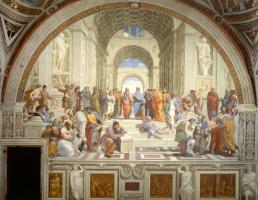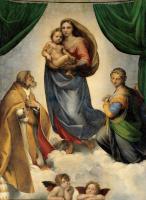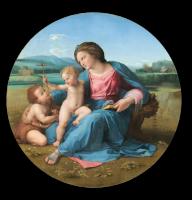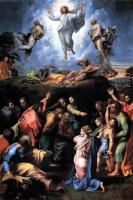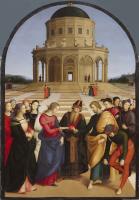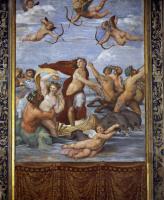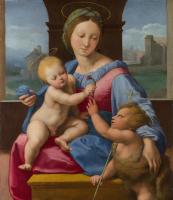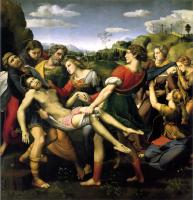Raphael (Raffaello Sanzio da Urbino)
So remarkable was Raphael’s talent that he became known as ‘the boy genius’; his reputation grew rapidly, and his career throughout his short life seems to have been effortless.
He was born and brought up in Urbino, an important provincial centre of art and literature in the Italian province of the Marches. In 1504 he moved to Florence, where he quickly absorbed all that the Florentine masters could teach him. He was soon considered to be the equal of his two greatest Renaissance contemporaries, Leonardo da Vinci and Michelangelo, although they were both somewhat older than him, and already well established.
In about 1508 he was summoned to Rome by Pope Julius 11, a great patron of the arts. Raphael produced a large number of devotional pictures and altarpieces for him and for his successor Pope Leo x, and he also painted portraits and designed interiors for many other wealthy Romans.
 The Alba Madonna is so called because for over one hundred years it was in
the collection of the Spanish Dukes of Alba. The painting is a tondo , a
circular format that was popular at the time, of the Madonna with the Christ
Child on her lap, seated serenely in the Italian country-side. The adoring
infant John the Baptist, clothed traditionally in animal skins, holds out a
cross of twigs to Christ. The Virgin Mary wears her customary blue cloak; the
haloes are fine wisps of gold. The bright soft colours and delicate detail of
the draperies and hair, and the circle of wild flowers round the feet of the
three figures, make an unusually light and beautiful composition. It is
remarkable for its serenity and perfect calm, although the cross is a reminder
of the suffering to come. The figures are grouped to the left, but the Virgin’s
arm and the billowing material of her cloak create a restful balance, its
harmony emphasized by the shape of the painting.
The Alba Madonna is so called because for over one hundred years it was in
the collection of the Spanish Dukes of Alba. The painting is a tondo , a
circular format that was popular at the time, of the Madonna with the Christ
Child on her lap, seated serenely in the Italian country-side. The adoring
infant John the Baptist, clothed traditionally in animal skins, holds out a
cross of twigs to Christ. The Virgin Mary wears her customary blue cloak; the
haloes are fine wisps of gold. The bright soft colours and delicate detail of
the draperies and hair, and the circle of wild flowers round the feet of the
three figures, make an unusually light and beautiful composition. It is
remarkable for its serenity and perfect calm, although the cross is a reminder
of the suffering to come. The figures are grouped to the left, but the Virgin’s
arm and the billowing material of her cloak create a restful balance, its
harmony emphasized by the shape of the painting.
The Alba Madonna reveals Raphael’s genius in the solving of a difficult problem : the convincing portrayal of three-dimensional figures on a flat surface. It is interesting to compare this picture with the work of the very early masters represented here, and to notice how dramatically painting had changed by the time of Raphael, particularly in the representation of the human figure. The woman and the two young children are not only three-dimensional, they are entirely realistic in their movements and in the way they express feeling in their faces and their gestures. This humanism and vitality was one of the most significant features of High Renaissance Italian art.

